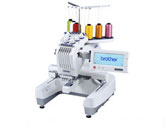PR-620/620C/600II/600IIC
FAQs & Troubleshooting |

PR-620/620C/600II/600IIC
Date: 08/10/2015 ID: faqh00000309_000
Fabric/stabilizer compatibility chart
| Fabric/ Garment | No. of Backing Pieces | No. of Topping Pieces | Comments |
|---|---|---|---|
| Terry cloth | 1 tear-away | 1 water-soluble | Increase density and/or satin stitch width.Fine details and small lettering tend to get caught in the terry loops. |
| Satin jacket |
Heavy lining: None Light or no lining: 1 tear-away |
None |
If garment slips in frame, causing alignment problems, wrap inner frame with masking tape or fabric bias tape. This provides a rough surface to grip garment and also helps minimize frame burn. |
| Cotton sheeting | 1 tear-away | None | High-density or highly detailed patterns may require more backing. If so, use two pieces of lightweight backing instead of one piece of heavy backing. |
| Denim | 1 tear-away | None | Reduce speed if needle begins to heat up and the thread breaks. |
| Headwear | Optional | Optional | Change needles more often than usual because the buckram backing dulls needles faster. A lightweight tear-away backing helps reduce thread breaks and regulates thread tension. Use a topping on corduroy or foam cap fronts. |
| Dress shirt (woven) | 1 tear-away | None | High-density or highly detailed patterns may require more backing.If so, use two pieces of lightweight backing instead of one piece of heavy backing. |
| Golf shirt | 1 cut-away | Optional | Use topping for patterns containing small lettering or a lot of detail, and also for pique knits. |
| Canton fleece | 1 tear-away | Optional | Use a topping if the garment has a textured surface, such as a basketweave or pronounced twill. |
| Canvas | 1 tear-away | None | Frame tightly |
| Corduroy | 1 tear-away | 1 water-soluble | A higher stitch density or more understitches, as well as a topping, may be necessary to prevent stitches from sinking into the fabric. |
| Lingerie or silk | 1 or 2 lightweight tear-away | Optional |
Reduce sewing speed. The thread tension should be low. Use topping for patterns with high detail or small lettering.For very fine fabrics, use a thinner thread. Avoid extremely narrow satin stitching on letters or details; instead increase satin stitch width or use a bean stitch. Gently remove (don't pull) backing and topping from garment. |
| Sweater knit | 1 cut-away or adhesive tea-away | 1 water-soluble | Use tightly woven organza or curtain fabric in a matching color as a backing for bulky or "holey" knits. |
| Sweatshirt | 1 cut-away or adhesive tear-away | Optional | Highly detailed patterns may require two layers of lightweight cut-away stabilizer. Use a topping on extra-thick fabrics or with fine-detail patterns. |
| T-shirt | 1 light-weight cutaway or adhesive tear-away | Optional |
Use a topping on patterns with fine detail or small lettering. Tensions should be light. Avoid stitch-heavy patterns. |
Due to the wide variety of fabrics and stabilizers available, the above information should be used as guideline only.
If unsure of a particular fabric/ stabilizer combination, please sew test a sample prior to the finished garment.
PR-1000, PR1000e, PR1X, PR-600/600C, PR-620/620C/600II/600IIC, PR-650/650C, PR650e/PR650eC, PR655/PR655C, PRS100
If you need further assistance, please contact Brother customer service:
Content Feedback
To help us improve our support, please provide your feedback below.
Step 1: How does the information on this page help you?
Step 2: Are there any comments you would like to add?
Please note this form is used for feedback only.
Please do not enter contact information or any other personal information here.
(We will not respond to any Feedback you send us.)